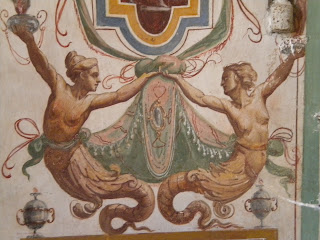My last Rome post was a bit forlorn, so I've been planning to share these pics for a while. Although my trip to the Domus Aurea wasn't super successful, the Vatican and its museums more than made up for it.
There were good examples of traditional grotesquerie everywhere, but the Galleria delle carte geografiche (Gallery of Maps) was an unexpected treasure trove.
The roof of the gallery is not gold. My camera had some kind of light-related spasm and refused to capture it correctly. Piece of rubbish.
Anyway, the real ceiling looks like this.
Grotesques everywhere.
The maps themselves were very nice.
The Vatican website explains that the gallery:
"takes its name from the 40 maps frescoed on the walls, which represent the Italian regions and the papal properties at the time of Pope Gregory XIII (1572-1585). They were painted between 1580 and 1585 on drawings by Ignazio Danti, a famous geographer of the time. Considering the Apennines as a partition element, on one side the regions surrounded by the Ligure and Tyrrhenian Seas are represented; on the other, the regions surrounded by the Adriatic Sea. The map of the main city accompanies each regional map."
Yes, yes. Very nice.
But really, stop wasting my time and talk about the grotesques.
Because they are incredible.
The best were around the recessed windows that line the hall, separating the maps. Running up the sides and across the tops of the windows, they are large, bright, and almost perfectly preserved. Say what you will about the church, they keep their stuff looking flash.
Because the windows are so large, and the decorations go right down to the ground, it gave me the opportunity to get what I'd been wanting for ages - clear, detailed close-ups. As a slightly, er, vertically-challenged person, it can be difficult to capture the features of wall frescoes. But these came right down to my eye level.
Because they face each other on either side of each window, the vertical streams of grotesques are often mirrored, but not exactly. Some of the pics below might seem identical, but if you look closely, they are all different. (Unless I've screwed up and uploaded something twice, in which case feel free to tell me I'm an idiot.)
This is one of the things I love about the traditional grotesque - the refusal of perfect symmetry, and no lazy copying. Every figure is unique, given its own special weird something.
Without further ado (click to enlarge):
These look like cactus wings. They might not be. Let's pretend they are!
Along with the Palazzo Vecchio in Florence, this was one of the highlights that really made my trip worthwhile. Hope you like.














































Hi Gwyneth!
ReplyDeleteI am very pleased to discover your blog and find the whole idea of your doctorate pretty fascinating. There's a lot here for me to catch up on and perhaps somewhere you've already done this but if not I do wish you were able to come up with a simple concise sentence describing grotesque.
Thanks!
Hi Scott, I'm glad you're enjoying the blog.
DeleteI would be wary of anyone who offers you a simple description of the grotesque - there are many varying definitions, which have evolved over time (in both cultural studies and art, which differ in their discussions of it).
This book gives a nice historical overview, if you're interested in reading more: http://www.amazon.com/Grotesque-Critical-Idiom-Philip-Thomson/dp/0416081800 Also, Kayser's book is a classic on the topic: http://www.amazon.com/The-Grotesque-Literature-Morningside-Book/dp/0231053371/ref=pd_sim_b_1
Thanks for commenting!